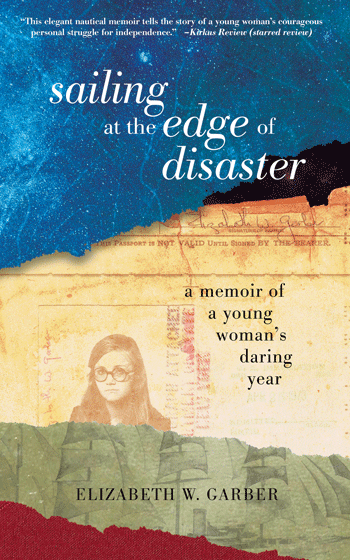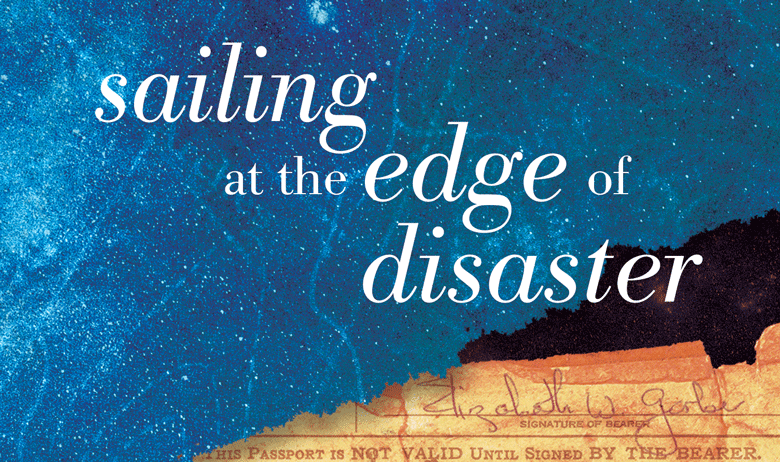Sailing at the Edge of Disaster: A Memoir of a Young Woman’s Daring Year
By Elizabeth W. Garber, Toad Hall Editions (2022)
Among the many weird things that were happening during the social upheavals of the 1960s and ’70s, one of the weirdest was the wholesale revolt of children against their parents. Of course parent-child enmities have never not existed. But in those decades an unusual resentment developed between the generations.
Every family stricken by those rifts dealt with them in their own ways, and Belfast resident Elizabeth Garber’s book Sailing at the Edge of Disaster, while superficially an account of her year on a star-crossed sailing vessel, is at its core an account of a family grappling with its own version of those troubles.
Garber tells us in mainly chronological order about her father’s decision in 1971 to send her, age 17, and her brother Woodie, 15, to an alternative school aboard the square-rigged sailing ship Antarna. We get a very uncomfortable picture of the emotional abyss between the kids and their overbearing father at home in Ohio. The father arranges for Elizabeth to be a summer assistant to the organizer, Stephanie, of the Oceanics School. By September the students and teachers are gathering at the ship docked in Miami.
Amid recollections of shipboard misadventures, Elizabeth returns persistently to her poisoned family life.
The ship is not ready to sail. The students are put to work on the extensive repair and maintenance projects needed to make the vessel seaworthy.
Elizabeth, being something of a bookworm and an obsessive journal writer, is charged with creating the onboard school library. It soon becomes apparent that not only is the ship not ready, but there isn’t much of a crew either, including no captain.

The narrative follows a kind of picaresque of events re-created from journals, letters, and other sources. Elizabeth forms a close friendship with another teenager escaping her family, Kim. Amid recollections of shipboard misadventures, Elizabeth returns persistently to her poisoned family life.
Late in the Miami part of the story, her father turns up unexpectedly to “help out” on the ship. When he announces at the end of his weeklong stay that he’s decided to remain and sail with them, Elizabeth and Woodie close ranks to stop him. This is a turning point for both the kids and the story.
Shortly afterward, more than halfway through the book, the Antarna is finally seaworthy, has secured a captain and crew, and sets sail. Even the departure, however, is complicated by legal obstacles stemming from frictions between organizer Stephanie and the ship’s owners who, for reasons unknown to the kids, seem to be undermining the project.
They sail to Key West, then Veracruz, Mexico, where murky maintenance and legal problems have to be addressed. The students are sent off to explore by themselves in Mexico, providing to the narrative a welter of episodes of wild rides, drunken fiascos, and close scrapes typical of what you’d likely expect of American youth turned loose with a backpack, a few dollars, and a bus ticket.
They then sail from Veracruz to the Panama Canal, with plans to sail on to the Galapagos Islands. A storm at sea makes up one of the story’s most vivid episodes.
In Panama, the trip comes to a bizarre end when the ship owners conspire with the Panamanian military to block the Antarna in the canal. Shots are fired. Amid a zoo of wayward adults—including the apparent con artist and probable procuress Stephanie—the kids have come to admire the old captain.
Like the father young Elizabeth seems always to have wanted, he comes through to get them all out safely.
The Antarna adventure is over. But the story continues on to detail the aftermath, involving partly an aborted project to find a second sailing gig, and particularly Elizabeth’s desire to deal with her family life. Back home in Ohio, she makes a detailed plan to kill her father.
The book is framed and infused by this fraught relationship. In the shadows of Sailing at the Edge of Disaster’s tale of teenagers’ life in a floating experimental school, is a picture of the troubling family issues that drove parts of the culture-wide youth rebellion in the tumultuous 1960s and ’70s.
Dana Wilde lives in Troy. He is a member of the National Book Critics Circle.





